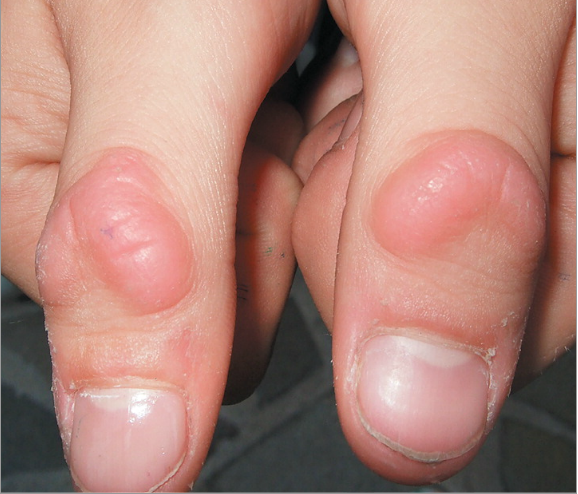
A healthy 10-year-old girl presented to her physician with nontender, well-circumscribed, mobile, slightly hyperkeratotic, erythematous plaques on the dorsal aspect of the interphalangeal joints of both thumbs. The plaques had developed over several months. These lesions were diagnosed as knuckle pads, a type of benign fibroma that typically occurs over the small joints of the hands and feet. Also known as Garrod's pads, these lesions have been associated with repetitive friction or pressure, as may occur with habitual chewing or sucking of the fingers, with repetitive occupational activities, with athletic activities (e.g., boxing and surfing), and with bulimia nervosa with self-induced vomiting. Knuckle pads have also been associated with a number of fibrosing disorders (such as Dupuytren's contracture, Ledderhose's syndrome, and Peyronie's disease), the autosomal dominant Bart–Pumphrey syndrome, and a variety of other medical conditions. As in this patient, knuckle pads in the pediatric population are often idiopathic. The patient was reassured regarding the benign nature of the condition, and no further treatment was recommended.
Knuckle Pads 指節墊
是一種特殊的自體免疫疾病,患者會在指節產生纖維化的腫塊。
Knuckle pads are benign, asymptomatic, well-circumscribed, smooth, firm, skin-colored papules, nodules, or plaques, located in the skin over the dorsal aspects of the metacarpophalangeal (MCP) and interphalangeal (IP) joints. A history of repetitive trauma related to sports or occupation is often present.
Garrod first described knuckle pads in the medical literature in 1893,[1] but knuckle pads have been observed since the Renaissance era. Allison et al shows a photo of Michelangelo's statue of David displaying knuckle pads (Florence, Italy) as well as his statue of Moses (Rome, Italy), Victory (Florence, Italy), and Giuliano de Medici (Rome, Italy).[2] The name knuckle pad seems to be a misnomer because in most reported cases, lesions occur over the proximal interphalangeal (PIP) joint, not over the knuckles.
Pathophysiology 病理學
Knuckle pads may be idiopathic, genetic, acquired as a response to repetitive trauma, or associated with several other acquired conditions.
Causes
Most knuckle pads are idiopathic or are related to repetitive trauma. Work-related trauma with repeated motions or rubbing of the PIP joints or knuckles, as seen in live-chicken hangers in a poultry processing plant,[4]has been reported. Athletes, such as boxers, have been known to traumatize their knuckles and fingers in a repetitive fashion, causing knuckle pads.[5, 6]Surfers have developed "surfer's knots" from repeated friction between the surfboard and the body part exposed to the repeated trauma.[7] A few cases involving the toes have been reported; these cases were thought to be sequelae of ill-fitting shoes.
Psychologically disturbed children who bite and suck their fingers cause thickenings that resemble knuckle pads to occur in the skin in the traumatized areas. Patients with bulimia who use their knuckles or fingers to induce emesis sometimes develop fibrotic papules resembling knuckle pads.[8]
Some cases of knuckle pads are familial. They have been associated with the autosomal dominant palmoplantar keratoderma with and withoutichthyosis vulgaris. Knuckle pads were found in 2 families with autosomal dominant sensorineural deafness and leukonychia (Bart-Pumphrey syndrome).[9] Knuckle pads also have been reported in pseudoxanthoma elasticum.[10, 11]Dupuytren disease, Peyronie disease, and Ledderhose disease are at times observed together, and the triad may be associated with knuckle pads.[12, 13, 14] Knuckle pads also have been associated withesophageal cancer,[15] hyperkeratosis,[16]oral leukoplakia,[15] and clubbed fingers.[17] One case report links phenytoin with polyfibromatous syndrome.[18]
Medical Care
Neither medical nor surgical interventions for knuckle pads are very effective. Eliminating the source of mechanical or repetitive trauma may improve the lesions. Wearing protective gloves or changing occupation may be necessary. Intralesional injections of corticosteroids or fluorouracil may reduce the size of the lesions.[21] Lesions caused by biting or sucking may require a psychiatrist to treat the underlying psychological problem. A cast or splint placed temporarily on the involved areas of the hand may aid in reducing the lesion. Application of silicone gel sheeting has had limited success.[22] Applications of keratolytics, such as salicylic acid or urea, have helped to soften and even reduce the lesions. Radiation therapy and application of solid carbon dioxide have been reported to be of some help in selected cases.
Surgical Care
Surgical intervention may be indicated if knuckle pads cause a functional problem. Recurrence after surgery is likely, especially if the trauma that caused the initial knuckle pad is not eliminated. Scar or keloid formation may result from surgical intervention. Tendon tethering, another surgical complication, occurs only if the joint space or capsule is accidentally cut with damage to the tendon in the attempt to remove the knuckle pad.
Medication Summary
The goals of pharmacotherapy are to reduce morbidity and prevent complications.
Keratolytics
Class Summary
Cause cornified epithelium to swell, soften, macerate, and then desquamate.
Salicylic acid topical (Dr. Scholl' s)
By dissolving the intercellular cement substance, produces desquamation of the horny layer of skin, while not affecting structure of viable epidermis.
Urea (Ureacin, Ureaphil, Carmol)
Promotes hydration and removal of excess keratin in conditions of hyperkeratosis. Available in 10-40% concentrations.





 留言列表
留言列表
 線上藥物查詢
線上藥物查詢 